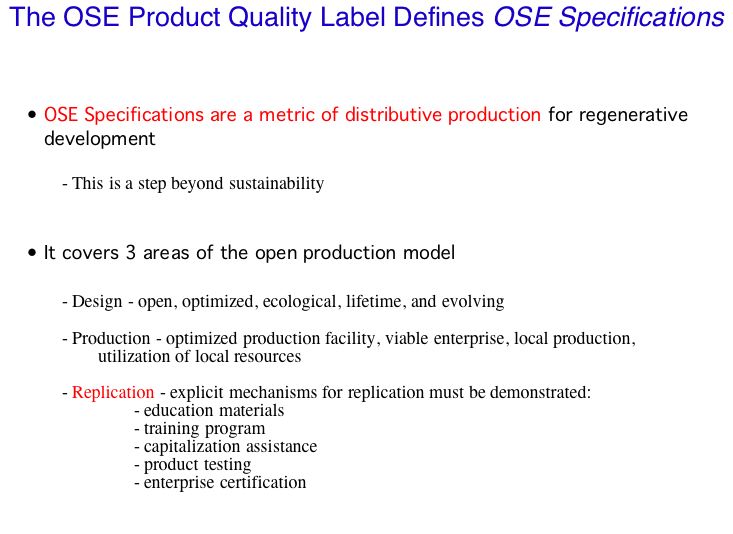Slide 24
This page was tagged as a candidate for deletion. If this page does not meet our criteria for deletion, please remove this notice.
(Explanation: contents moved to Slide 1)
Slide 1 - Slide 2 - Slide 3 - Slide 4 - Slide 5 - Slide 6 - Slide 7 - Slide 8 - Slide 9 - Slide 10 - Slide 11 - Slide 12 - Slide 13 - Slide 14 - Slide 15 - Slide 16 - Slide 17 - Slide 18 - Slide 19 - Slide 20 - Slide 21 - Slide 22 - Slide 23 - Slide 24 - Slide 25 - Slide 26 - Slide 27 - Slide 28 - Slide 29 - Slide 30 - Slide 31 - Slide 32 - Slide 33
The OSE Specifications are a metric for distributive production. This means, we are creating a standard for what it would mean to make good enterprise replicable – such that the world becomes a better place. We are interested in a step beyond sustainability – the regeneration of our ecosystems and communities – or regenerative development.
OSE Specifications are the standard for transparency regarding the qualities of a product that make that product contribute to distributive production. The rating is expressed as a 5 star rating. When a product achieves 5 stars, it is said to meet OSE Specifications. Each of the qualities of Design-Production-Replication is considered and described on the product label to promote the transparency.
For example, the five stars of design are: (1) open design and process, such as availability of CAD drawings and CAM files, (2) bill of materials and sourcing information, (3) optimization of design, (4) lifetime design, (5) evolution of product.
Sound design is not enough. Next is production. (1) An flexible production facility must be demonstrated. (2) A viable distributed enterprise model must be shown. (3) The enterprise must rely on local production. (4) Local materials must be used as much as possible. (5) On-demand, optimized production must be shown.
Sound production is also not enough to meet OSE Specifications. If we are truly interested in transformative, regenerative enterprise, then we must also consider replication of the enterprise for distributed wealth production. To replicate successfully, the five points considered are: (1) Availability of training materials. (2) Availability of a hands-on training or apprenticeship program. (3) Capitalization assistance, such as utilizing the training period to produce the related equipment and machinery. (4) Product testing must be available to document the resulting performance. (5) A certifying organization must be able to assess the product according to OSE Specifications, and to provide a rating and a transparency label.
As you see, OSE Specifications are a rigorous set of conditions. At present, the CEB press has only one or two stars – which shows that the prototype that has been built is only a small fraction of the process.
